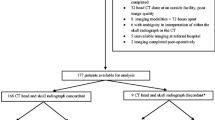Abstract
Skull fracture is a common finding following head trauma. It has a prognostic significance and its presence points to severe trauma. Additionally, there is a greater possibility of detecting associated small underlying extra-axial hematomas and subtle injuries to the brain parenchyma. In pediatric patients, the presence of multiple open sutures often makes fracture evaluation challenging. In our experience, 3D volume (3DV)-rendered CT images complement routine axial bone window (RBW) images in detection and characterization of fractures. This is a multi-reader, multi-case, paired retrospective study to compare the sensitivity and specificity of RBW and 3DV images in detection of calvarial fractures in pediatric patients. A total of 60 cases (22 with fractures and 38 without) were analyzed. Two experienced neuroradiologists and a radiology trainee were the readers of the study. For all readers, the sensitivity was not statistically different between the RBW and the 3DV interpretations. For each reader, there was a statistically significant difference in the interpretation times between the RBW and the 3DV viewing formats. A greater number of sutural diastasis was identified on 3DV. We propose that 3DV images should be part of routine head trauma imaging, especially in the pediatric age group. It requires minimal post-processing time and no additional radiation. Furthermore, 3DV images help in reducing the interpretation time and also enhance the ability of the radiologist to characterize the calvarial fractures.





Similar content being viewed by others
References
Pekcevik Y, Hasbay E, Pekcevik R (2013) Three-dimensional CT imaging in pediatric calvarial pathologies. Diagn Interv Radiol. doi:10.5152/dir.2013.13140
Kapil Saigal RSW (2005) Use of three-dimensional computerized tomography reconstruction in complex facial trauma. Facial Plast Surg FPS 21(3):214–220. doi:10.1055/s-2005-922862
Fox LA, Vannier MW, West OC, Wilson AJ, Baran GA, Pilgram TK (1995) Diagnostic performance of CT, MPR and 3DCT imaging in maxillofacial trauma. Comput Med Imaging Graph Off J Comput Med Imaging Soc 19(5):385–395
Samii M, Tatagiba M (2002) Skull base trauma: diagnosis and management. Neurol Res 24(2):147–156. doi:10.1179/016164102101199693
Ringl H, Schernthaner RE, Schueller G et al (2010) The skull unfolded: a cranial CT visualization algorithm for fast and easy detection of skull fractures. Radiology 255(2):553–562. doi:10.1148/radiol.10091096
Sanchez T, Stewart D, Walvick M, Swischuk L (2010) Skull fracture vs. accessory sutures: how can we tell the difference? Emerg Radiol 17(5):413–418. doi:10.1007/s10140-010-0877-8
Wei SC, Ulmer S, Lev MH, Pomerantz SR, González RG, Henson JW (2010) Value of coronal reformations in the CT evaluation of acute head trauma. AJNR Am J Neuroradiol 31(2):334–339. doi:10.3174/ajnr.A1824
Sodickson A, Okanobo H, Ledbetter S (2011) Spiral head CT in the evaluation of acute intracranial pathology: a pictorial essay. Emerg Radiol 18(1):81–91. doi:10.1007/s10140-010-0914-7
Prabhu SP, Newton AW, Perez-Rossello JM, Kleinman PK (2013) Three-dimensional skull models as a problem-solving tool in suspected child abuse. Pediatr Radiol 43(5):575–581. doi:10.1007/s00247-012-2546-4
Viel G, Cecchetto G, Manara R, Cecchetto A, Montisci M (2011) Role of preoperative 3-dimensional computed tomography reconstruction in depressed skull fractures treated with craniectomy: a case report of forensic interest. j forensic med 32(2):172–175. doi:10.1097/PAF.0b013e318219c88c
Kim Y-I, Cheong J-W, Yoon SH (2012) Clinical comparison of the predictive value of the simple skull x-ray and 3 dimensional computed tomography for skull fractures of children. J Korean Neurosurg Soc 52(6):528–533. doi:10.3340/jkns.2012.52.6.528
Demant AW, Bangard C, Bovenschulte H, Skouras E, Anderson SE, Lackner KJ (2010) MDCT evaluation of injuries after tram accidents in pedestrians. Emerg Radiol 17(2):103–108. doi:10.1007/s10140-009-0844-4
Kuszyk BS, Heath DG, Bliss DF, Fishman EK (1996) Skeletal 3-D CT: advantages of volume rendering over surface rendering. Skelet Radiol 25(3):207–214
Conflict of interest
The authors declare that they have no conflict of interest.
Author information
Authors and Affiliations
Corresponding author
Rights and permissions
About this article
Cite this article
Dundamadappa, S.K., Thangasamy, S., Resteghini, N. et al. Skull fractures in pediatric patients on computerized tomogram: comparison between routing bone window images and 3D volume-rendered images. Emerg Radiol 22, 367–372 (2015). https://doi.org/10.1007/s10140-015-1300-2
Received:
Accepted:
Published:
Issue Date:
DOI: https://doi.org/10.1007/s10140-015-1300-2




